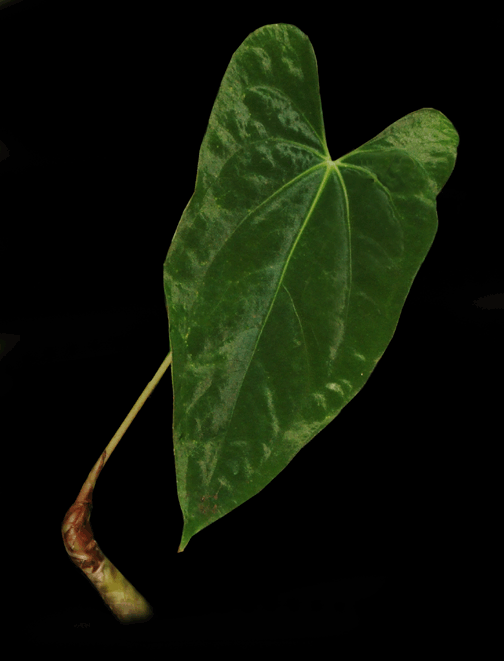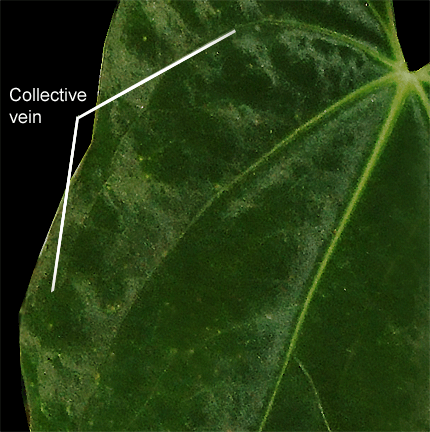![]()
Aroids and other genera in the Collection
Take the Tour Now?
Orchids
The
Exotic Rainforest
Plants in
the Exotic Rainforest Collection
The images on this website are copyright protected. Please contact us before any reuse.
Detailed information on Growing Anthurium Species
Click this Link
The Exotic Rainforest is a private botanical garden.
Within our collection we have many species of Anthurium. If you are seeking other photos, click this link:
Anthurium papillilaminum
Croat

Originally collected in
Panama by Elaine Spear, Anthurium papillilaminum is exclusively
found in (endemic to) Panama, Anthurium papillilaminum was
published to science by aroid botanist Dr. Thomas B. Croat Ph.D., P.A.
Schulze Curator
of Botany of the Missouri Botanical Garden in St. Louis
in 1986 in the Missouri Botanical Garden's Monographs in
Systematic
Botany. Anthurium papillilaminum grows as a terrestrial
Anthurium in soil.
 Based
on information published by Dr. Croat the leaves and petiole of
Anthurium papillilaminum stand erect The petioles which support the
leaf blades typically measure 16.5 to 34 cm (6.5 to 13.4 inches) in
length and are subterete. A subterete petiole is one that is just less
than round. The subcoriacious leaves (less than leathery) are
typically a dark olive green and may be tinged with red to violet red.
The geniculum which is a common characteristic of Anthurium species is
not easily apparent at the top of the petiole but can be felt between
your fingers if you rub them across the upper petiole's surface. The geniculum
allows the leaf blade to rotate in to orient itself to the
brightest source of light and is sometimes tinged with a violet red.
Based
on information published by Dr. Croat the leaves and petiole of
Anthurium papillilaminum stand erect The petioles which support the
leaf blades typically measure 16.5 to 34 cm (6.5 to 13.4 inches) in
length and are subterete. A subterete petiole is one that is just less
than round. The subcoriacious leaves (less than leathery) are
typically a dark olive green and may be tinged with red to violet red.
The geniculum which is a common characteristic of Anthurium species is
not easily apparent at the top of the petiole but can be felt between
your fingers if you rub them across the upper petiole's surface. The geniculum
allows the leaf blade to rotate in to orient itself to the
brightest source of light and is sometimes tinged with a violet red.
The adaxial (upper) surface has a velutinous (velvet) blade that is velutinous without
any whitish venation in the veins. As a result of the velvet appearance Anthurium
papillilaminum is a member of Anthurium section Cardiolonchium.
A common characteristic of Anthurium species is the collective
vein which can be observed close to the edge of the leaf blades. The
collective vein of Anthurium papillilaminum begins from the
first
basal vein and does not completely encircle the leaf. The
cataphyll, which is the modified leaf that surrounds any newly emerging
leaf dries to fibers that persist on the vine.
An aroid, all Anthurium species reproduce via the production of
an inflorescence. An aroid, all Anthurium species
reproduce via the production an inflorescence. The stalk that supports
the entire inflorescence is the peduncle. When an Anthurium is
"in flower" the reference is to the tiny flowers containing both male
and female sexual parts that grow on the spadix at the center of the
inflorescence. Unlike plants in the genus Philodendron which
contain imperfect flowers having only a single sex Anthurium
possess perfect flowers containing both sexes. To help prevent self
pollination nature has designed the female flowers to be receptive
before the male portion of the flower produce their pollen so in most
cases an insect must bring pollen from another plant.
When an Anthurium is "in flower" the
reference is to the tiny
 flowers that grow on the spadix
at the center of the inflorescence. The
spathe is not a "flower" but instead is a modified leaf. The spadix at
its center vaguely resembles an elongated pine
cone. Once the female portion of the flowers on the spadix are ready to reproduce during
anthesis (sexual reproduction) they must be pollinated by an insect,
normally a beetle. If pollinated they will produce berries.
Each berry contains one to two seeds. The
colorful berries are then eaten by birds and other rain forest animal
species that spread them among the forest in their droppings.
flowers that grow on the spadix
at the center of the inflorescence. The
spathe is not a "flower" but instead is a modified leaf. The spadix at
its center vaguely resembles an elongated pine
cone. Once the female portion of the flowers on the spadix are ready to reproduce during
anthesis (sexual reproduction) they must be pollinated by an insect,
normally a beetle. If pollinated they will produce berries.
Each berry contains one to two seeds. The
colorful berries are then eaten by birds and other rain forest animal
species that spread them among the forest in their droppings.
The inflorescence of Anthurium papillilaminum stands erect and is
held above the leaves. The spathe is green and
tinged with purple red. The spathe reflexes (turns back) while the
spadix is green to yellow green. Anthurium species are known to be highly variable and not every leaf of every
specimen will always appear the same. This link
explains in non-technical language natural variation and morphogenesis
within aroid species. Morphing is very
commonly seen in Anthurium species.
Click here.
Enid Offolter's photo is
courtesy natural Selections Exotics,
Specimens may be available
from Natural Selections Exotics
![]()
or Brian's Botanicals
http://www.briansbotanicals.net/

Join the International Aroid Society: http://www.exoticrainforest.com/Join%20IAS.html
Aroid Pollination!
As it occurs in nature and
by any horticulturist
Need more information on Anthurium species?
Click this link.